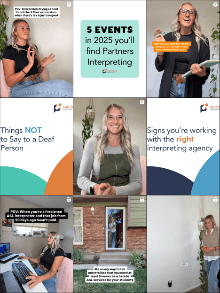September has started with a wave of stories underscoring both the celebration and the challenges of Deaf culture and accessibility. Deaf Awareness Month set the tone with events worldwide and digital campaigns closer to home. Meanwhile, researchers and policymakers delivered important updates: from a Department of Justice settlement expanding ASL rights in prisons, to new AI models that better recognize unfamiliar signs, to local governments piloting services that make public life more accessible.
Education and workforce development are also in the spotlight. RIT launched a pathway into medical school for Deaf students, while coverage of interpreter shortages highlighted persistent barriers in classrooms. Technology plays a recurring role, whether in experimental robotics or in the push for Deaf-led governance of AI.
Taken together, these stories show that accessibility is not static. Progress requires a mix of celebration, innovation, and accountability. This week’s highlights capture how cultural observance, policy enforcement, and creative engineering all intersect to push equity forward.
Deaf Awareness Month

Each September, Deaf Awareness Month brings renewed attention to Deaf culture, American Sign Language (ASL), and the ongoing effort to expand accessibility. The observance traces back to the World Federation of the Deaf’s International Week of the Deaf, first held in 1958 and still observed during the last full week of September. Over time, the celebration has grown into a month-long occasion for advocacy, education, and community pride.
Deaf-led organizations, schools, and universities often host events showcasing ASL storytelling, theater, art, and forums on policy issues. Hearing allies are encouraged to participate, learning how practices such as captioning and professional interpreting strengthen inclusion. Many initiatives echo the theme “No Human Rights without Sign Language Rights,” underscoring the principle that language access is a matter of equity and dignity.
This year, along with academic and advocacy events, digital platforms are playing a central role. The amazing team at Partners is contributing by curating a series of posts on Instagram, highlighting Deaf history, cultural insights, and practical resources for allies and families. These short-form stories are designed to be shareable, helping spread awareness beyond formal events and into everyday digital spaces. Please like and subscribe :).
Whether through community workshops, cultural festivals, or social media campaigns, Deaf Awareness Month continues to remind the broader public that accessibility is not a side issue but an essential part of building inclusive societies.
Deaf AI Models Generalize Better

Current systems often fail when presented with signs outside their training set. To address this, the researchers built two phonologically informed enhancements into a vector-quantized autoencoder. One separated different sign components in the model, and another guided training with phonological rules. In controlled tests, these changes improved accuracy when recognizing previously unseen signs.
While the system is not ready for fluent conversation, it moves beyond static dictionary-style tools. For Deaf communities, the promise lies in more reliable learning resources, captioning aids, and sign-translation systems that do not break when a new sign appears. Advocates emphasize that development must remain Deaf-led to avoid bias and ensure regional dialects are represented.
DOJ Settlement Expands ASL in Prisons
The U.S. Department of Justice announced a settlement with the Arkansas Department of Corrections to address long-standing violations of the Americans with Disabilities Act. The case centered on Deaf and Hard-of-Hearing inmates who lacked access to qualified interpreters, captioning, and other auxiliary aids. These gaps blocked communication in vital areas such as medical care, legal proceedings, education programs, and daily interactions with staff.
Under the settlement, Arkansas must provide qualified ASL interpreters, improve access to assistive technologies, and train correctional staff on disability rights requirements. Compliance will be monitored by DOJ to ensure reforms are not just on paper but implemented consistently across facilities.
For Deaf inmates, the changes could mean a shift from isolation and missed services to meaningful participation in prison programs and better healthcare access. For corrections officials, the settlement highlights both legal obligations and practical challenges, including the shortage of certified interpreters and the need to integrate accessibility into staff training and facility planning.
The case reinforces that the ADA applies fully inside prisons. It also signals DOJ’s continued readiness to enforce communication rights in settings beyond schools and hospitals. Advocates are likely to view this as a precedent for broader reforms in correctional systems nationwide, where similar complaints have been filed.
NC Marks 2 years of 988 ASL
North Carolina’s Department of Health and Human Services observed “988 Day” on September 3 by celebrating the second anniversary of American Sign Language access on the national Suicide & Crisis Lifeline. Since 2023, Deaf and Hard-of-Hearing callers in the state have been able to connect directly with crisis counselors through an ASL video option, removing the need for voice relay or third-party interpretation during emergencies.
At the anniversary event, officials joined Deaf advocates to highlight how the service works and to provide training for staff on accessibility. The ASL option is available nationwide, but North Carolina has been one of the more visible states in promoting it and gathering community feedback.
The program reflects compliance with both the ADA and federal guidance around 988, but it also illustrates a broader shift toward embedding accessibility in life-saving services. Key questions remain about how consistently these calls are answered within parity targets, and whether counselors receive ongoing training in Deaf culture and trauma-informed care. Advocates note that publishing call metrics would help ensure quality matches availability.
Cambridge report urges Deaf-led AI
The University of Cambridge’s Minderoo Centre for Technology and Democracy released a report titled “BSL is Not for Sale,” calling for Deaf leadership in the procurement of sign-language AI systems across public services. The report warns that without community governance, these tools risk reinforcing inequality in areas such as education, healthcare, and justice.
The authors recommend concrete measures for UK government bodies: establishing Deaf-majority review panels, including enforceable accessibility clauses in contracts, and requiring transparency about system accuracy and bias.
They also highlight the need for redress mechanisms when technology fails in high-stakes situations. Crucially, the report practices what it preaches by offering its findings in accessible formats, including British Sign Language summaries.
The report lands as the UK continues implementing the BSL Act and debating broader AI governance. If adopted, its recommendations could set a precedent internationally, reshaping how public agencies buy and deploy accessibility technologies. The key question ahead is whether procurement rules will evolve to reflect these principles or remain stuck at the level of pilot projects and good intentions.
NTID screens ‘Deaf President Now!’
Rochester Institute of Technology’s National Technical Institute for the Deaf (NTID) hosted a community screening of Deaf President Now! on September 4. The documentary revisits the landmark 1988 student protest at Gallaudet University, which led to the appointment of the school’s first Deaf president and became a touchstone for disability rights activism in the United States.
NTID President Caroline Solomon, who is the institute’s first Deaf woman president, addressed the audience with an interpreter and emphasized the enduring lesson of the protest: Deaf people are fully capable of leading major institutions. Attendees discussed how the movement paved the way for the Americans with Disabilities Act and other advances in accessibility law and policy.
Putting the Gallaudet protests back in the spotlight, NTID underscored how community action can transform institutions and inspire the next generation of leaders.
Pathway for Deaf Med Students
Rochester Institute of Technology (RIT) and the University at Buffalo announces the Early Opportunity Program in Medicine (EOPIM), a new initiative designed to open medical school pathways for students from underrepresented backgrounds, including Deaf and Hard-of-Hearing undergraduates.
Eligible RIT students who maintain strong academic performance and have faced educational barriers can apply for early conditional admission to UB’s Jacobs School of Medicine. The program provides academic mentoring, MCAT preparation, and career coaching. It also recognizes that many talented students encounter hurdles outside of grades alone, such as limited access to shadowing opportunities, the high cost of test prep, and bias in admissions processes.
More details are here >>> https://www.rit.edu/news/rit-partners-ub-offer-path-medical-school
Wolverhampton Expands BSL Access
The City of Wolverhampton Council announced a new British Sign Language (BSL) video relay service to improve communication between Deaf residents and local government staff. The system allows three-way video calls that connect citizens directly with qualified interpreters, ensuring that routine interactions such as council tax inquiries or housing services can be handled more smoothly.
In addition to on-demand video interpreting, the council offers a process for booking in-person BSL interpreters for longer or more complex meetings. This blended model is a recognition that while video relay is useful for quick contact, in-person interpreting is still essential for sensitive or detailed discussions.
Challenges remain in areas such as ensuring staff are trained to use the system effectively, protecting data privacy during calls, and keeping wait times reasonable. Still, Wolverhampton’s adoption sets an example for other UK municipalities, many of which have yet to embed BSL services into their front-line operations.
Low-cost Robot Fingerspells ASL

23 off-the-shelf servo motors, 3D-printed joints, and an Arduino brain driving the movements. The point is not to wow with sleek design, but to show that a working teaching tool can be built cheaply and shared openly.
In tests, the hand managed all 26 letters, with versions for both left- and right-hand configurations.
Test observers recognized most letters, though the researchers admitted that smoothness matters. Transitioning between letters, adjusting wrist angles, and getting the pacing right are all challenges that this model does not fully solve.





